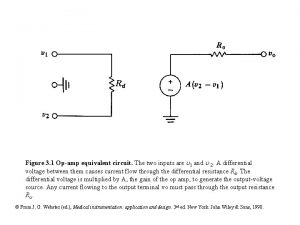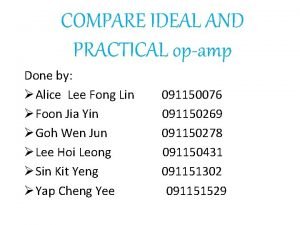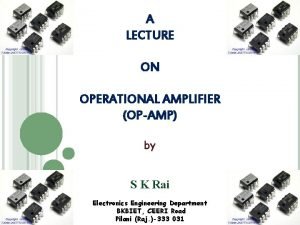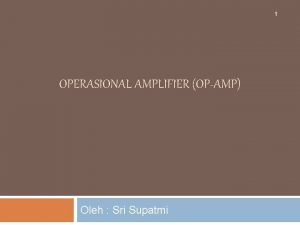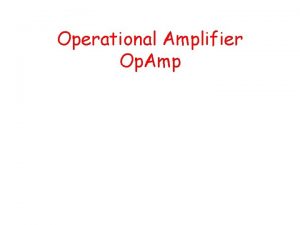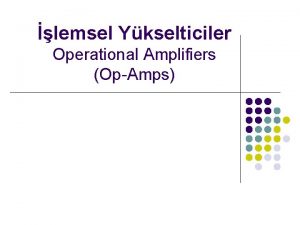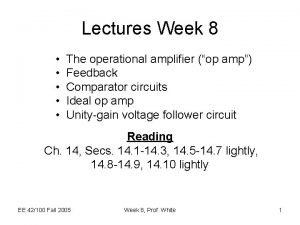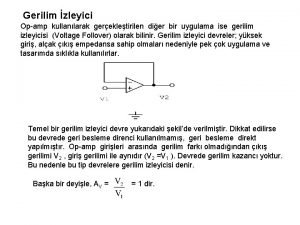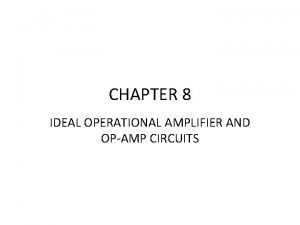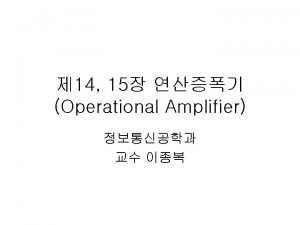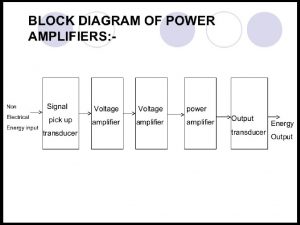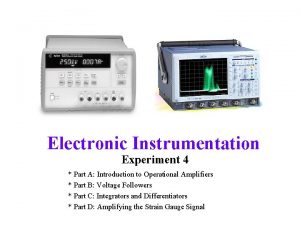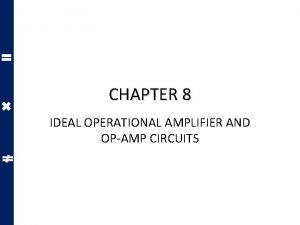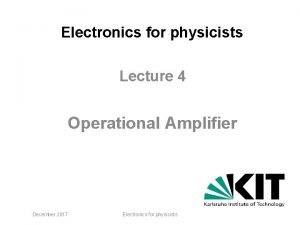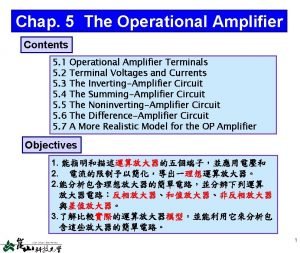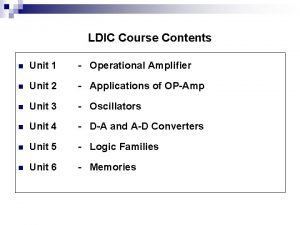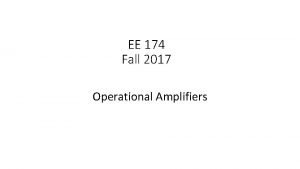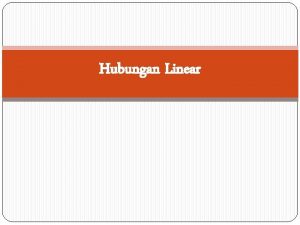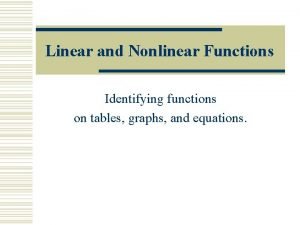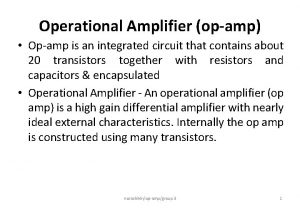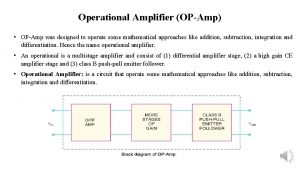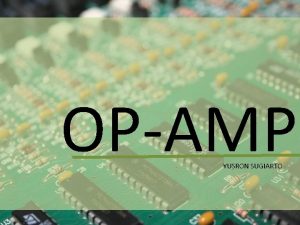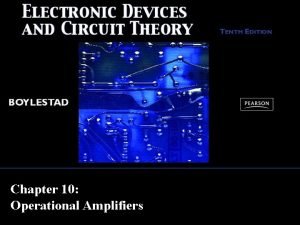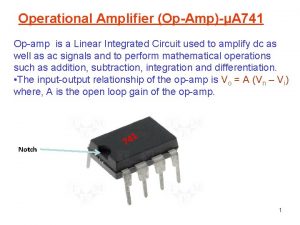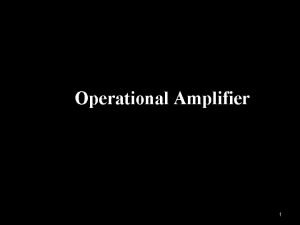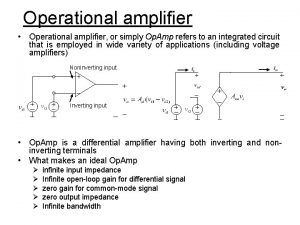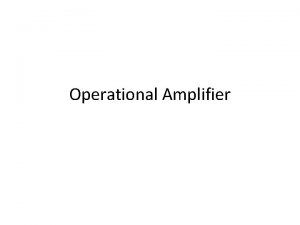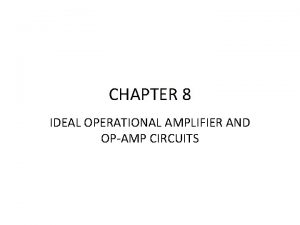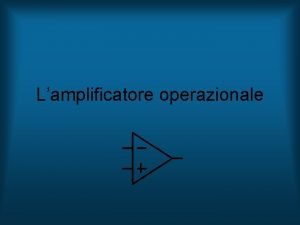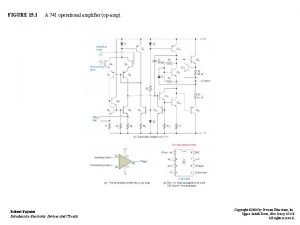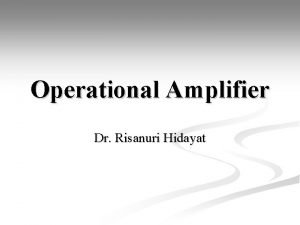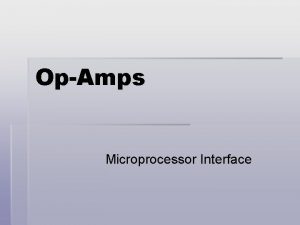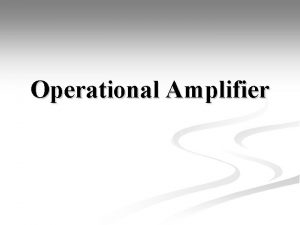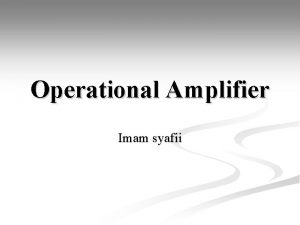Operational Amplifier Linear Introduction Operational amplifier or opamp





































- Slides: 37

Operational Amplifier Linear

Introduction ØOperational amplifier or op-amp is a circuit of components integrated into one chip (IC Series 741). ØWe will study the op-amp as a singular device introduction

Op-Amp ØOp-amp is a high-gain dc amplifier that has high input impedance and low output impedance. ØA typical op-amp is powered by two dc voltages and has an inverting(-) and a non-inverting input (+) and one output. introduction

Op-Amp Five important pins – – – introduction 2 – The inverting input 3 – The non-inverting input 6 – The output 4 – The negative power supply V- (-Vcc) 7 – The positive power supply V+ (+Vcc)

Op-Amp Symbols ØSymbol shown in a most commonly use; introduction

Basic Op-Amp ØInput terminal (+) is called noninverting input (V+) and input terminal (-) is called inverting input (V-). ØVo will be in phase with the input at V+ , while it will be 180° out of phase with the input at V. ØThe used of +ve and –ve supply voltages allows the output to swing in both +ve and –ve directions. introduction

Basic Op-Amp introduction

Basic Op-Amp ØAn ideal op-amp has infinite gain and bandwidth, we know this is impossible. ØHowever, op-amps do have: Øvery high gain Øvery high input impedance(Zin = ∞) Øvery low output impedance (Zout = 0) Øwide bandwidth. introduction

Op-Amp Transfer Characteristic ØThree regions of operation: linear region, negative saturation region and positive saturation region. introduction

Op-Amp Transfer Characteristic Positive Saturation – where the output voltage exceeds the positive power input Linear Region – where the output voltage is linear based on A (gain) Negative Saturation – where the output voltage would be less than the negative power input

Op-Amp Transfer Characteristic introduction

Op-Amp DC Offset Parameters Input Offset Voltage ØOp-amps tend to produce a small dc voltage called output error voltage (VOUT(error)). ØThe data sheet provides the value of dc differential voltage needed to force the output to exactly zero volts. This is called the input offset voltage (VIO). introduction

Op-Amp DC Offset Parameters Input Offset Voltage introduction

Example Sketch the op-amp transfer characteristic given open loop gain (AOL) = 103 and offset voltage (VOI) = 10 m. V. The op-amp is supplied with ± 10 V. Give the range of the linear and non linear region. Since VOI = 10 m. V so we need to shift 10 mv to the left Solutions: Given AOL = 103 and op-amp is supplied with ± 10 V introduction Linear Region: -20 m. V ≤ Vin ≤ 0 V Non-Linear : Vin > 0 V, Vin < -20 m. V

Op-Amp DC Offset Parameters ØThere are other input parameters to be considered for opamp operation. The input bias current is the dc current required to properly operate the first stage within the opamp. The input impedance is another. Also, the input offset current—which can become a problem if both dc input currents are not the same. ØOutput impedance and slew rate—the response time of the output with a given pulse input—are two other parameters. introduction

Application in Op-Amp • There are 2 types of application in op-amp – Linear application – Non-linear application • Linear application is where the op-amp operate in linear region: – Assumptions in linear application: • Input current, Ii = 0 • Input voltage: V+=V • Feedback at the inverting input application

Application in Op-Amp • Non-linear application is where the op-amp operate in non-linear region • By comparing these two input voltages: positive input voltages, V+ and negative input voltage, V- where: VO = VCC if V+ > VVO = -VCC if V+ < V • Input current, Ii = 0 application

Op-amp Circuit Application – Non-Inverting Amplifier – Summing Amplifier – Unity Follower – Difference Amplifier – Integrators – Differentiators application

Linear Applications application

Linear Applications • Consider non-inverting configuration…

Linear Applications • The Concept of Virtual Circuit Ø Thus, for non-inverting configuration, we can assume that a short circuit exists between the two input terminals. application

Linear Applications • Non-Inverting Amplifier application

Linear Applications • Non-Inverting Amplifier application

Linear Applications • Inverting Amplifier ØThe input signal and feedback signal are both applied to the inverting output application

Linear Applications • Concept of the Virtual/Earth Ground application

Linear Applications • Inverting Amplifier ØThus for inverting configuration, we can assume that the inverting input is virtually connected to ground application

Linear Applications • Inverting Amplifier application

Linear Applications • Inverting Amplifier application

Linear Applications • Unity Follower ØProvides a gain of unity (1) From the circuit; Vo = V Where as we known; V-=V+ Hence; Vo = V + = V 1 application

Linear Applications • Summing Amplifier Ø Also known as weighted summer IRf IR 1 IR 2 Ii = 0 IR 3 application

Linear Applications • Difference Amplifier IR 4 IR 2 Ii = 0 IR 1 Ii = 0 IR 3 application

Linear Applications • Difference Amplifier IR 4 IR 2 Ii = 0 IR 1 Ii = 0 IR 3 application

Linear Applications • Difference Amplifier IR 4 IR 2 Ii = 0 IR 1 Ii = 0 IR 3 application

Exercise 1 Identify OP 1 and OP 2. Find VO 1 and VO OP 1 exercise VO 1 OP 2

Exercise 2 Identify OP 1, OP 2 and OP 3. Find V 2 and V 3 OP 2 OP 1 VO 1 OP 3 exercise

Exercise 3 Identify OP 1, OP 2 and OP 3. Find VO OP 1 OP 3 OP 2 exercise

Exercise 4 Find VO? exercise
 Op amp equivalent circuit
Op amp equivalent circuit Characteristics of ideal and practical op amp
Characteristics of ideal and practical op amp Op amp sembolü
Op amp sembolü Open loop configuration of op-amp
Open loop configuration of op-amp Contoh soal op amp non inverting
Contoh soal op amp non inverting Voltage subtractor
Voltage subtractor 709 op amp
709 op amp Differential amplifier
Differential amplifier Opamp
Opamp Ideal op
Ideal op What is virtual ground?
What is virtual ground? Power amplifier vs voltage amplifier
Power amplifier vs voltage amplifier Multistage amplifier conclusion
Multistage amplifier conclusion Penguat operasional
Penguat operasional Operational amplifier experiment
Operational amplifier experiment Operational amplifier inverter
Operational amplifier inverter Operational amplifier
Operational amplifier Inverting summer
Inverting summer Ic 741 has i/p impedance of 2mq.
Ic 741 has i/p impedance of 2mq. Ideal op amp assumptions
Ideal op amp assumptions Operational amplifiers
Operational amplifiers Simple multiple linear regression
Simple multiple linear regression Contoh soal metode biseksi
Contoh soal metode biseksi Non linear text
Non linear text Non linear plot definition
Non linear plot definition Persamaan non linier metode numerik
Persamaan non linier metode numerik Non linear pipeline processors
Non linear pipeline processors What is multimedia?
What is multimedia? Left-linear grammar
Left-linear grammar Perbedaan fungsi linear dan non linear
Perbedaan fungsi linear dan non linear Non linear function
Non linear function Linear independence
Linear independence Linear algebra linear transformation
Linear algebra linear transformation Penggal dan lereng garis lurus
Penggal dan lereng garis lurus Linear impulse and momentum
Linear impulse and momentum Persamaan linier simultan adalah
Persamaan linier simultan adalah How to identify linear functions from tables
How to identify linear functions from tables Table is linear or nonlinear
Table is linear or nonlinear
